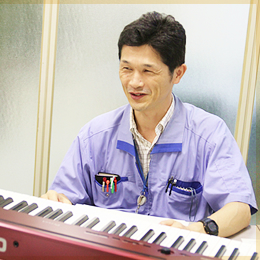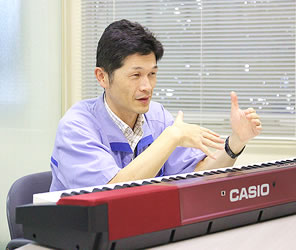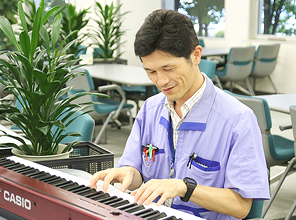Developer
Jin Tomita
In charge of product development for the first Privia digital piano




Background to Creation of the Privia Series and Objectives
Put simply, the starting point for development of the Privia was defiance of the prevailing conventional wisdom. In those days, digital pianos were considered a mere substitute for acoustic pianos, and most digital pianos had classical, dignified designs. To go in the opposite direction, we set forth an unconventional concept. We would develop the world's smallest digital piano, which would be half the size and half the price of previous models. As a matter of fact, opinions and comments from CASIO's electronic keyboard users helped inform the concept. As a result, the idea met with widespread acceptance, and CASIO succeeded in creating the new product category: stylish and compact digital pianos. An additional happy effect of the development of the Privia is that digital pianos became a more familiar product that came to be sold at home appliance mass merchandisers as well as specialty music stores, which increased encounters with customers.
Combining High Quality and Functionality with Size and Weight Reduction
The first critical development issue was how many functions and how much ease of use we could build into the instrument while achieving a compact body design. An easy-to-understand example of the design dilemma is the keyboard. Although hammer action that takes up space inside the piano is necessary for duplicating the natural action and touch of an acoustic piano keyboard, we also had to pursue size reduction. A great deal of ingenuity was required to achieve both objectives. The pursuit of weight reduction involved similar tradeoffs. For instance, replacing the steel plate used to support the keyboard with a lightweight plastic material would result in insufficient strength. We wrestled with such tradeoffs time and again and performed countless simulations before finally arriving at the Privia's basic structure, which in fact has been retained in the newest models.


The Appeal of the Privia Is the Result of Strong Conviction of Purpose
I think that the strength of the Privia from the standpoint of development is that we resolutely and uncompromisingly pursue the development concept. Creating the world's smallest digital piano, and furthermore, reducing the weight by half was by no means a simple undertaking. I think that it is precisely the difficulty involved in developing the Privia that led to the establishment of its unique product personality, the pioneering of the "stylish and compact" product category, and the widespread popularity of Privia digital pianos among users. If the product concept had lacked specificity-for instance, if we had sought to develop a "smaller and lighter piano" and development had ended with a product 70-80% of the weight and price of previous models-the Privia might not exist as we know it today.
The Challenge of Developing Tenth Anniversary Models
With the tenth anniversary models, we have taken a rather daring design approach. The PX-A100 features metallic red and blue colours that depart from the stereotypical subdued hues associated with pianos. For the PX-A800, we boldly used a woodgrain pattern that straightforwardly expresses the texture of wood. I'm looking forward to the reaction of customers to both models.
In addition to their novel appearance, these digital pianos feature several distinctive functions. First of all, the new Hall Simulator function can simulate the acoustics of ten different kinds of concert venues, including famous concert halls around the world, a cathedral, and an outdoor stadium. We also incorporated ten preset grand piano tones that correspond to various musical styles, such as rock and jazz. Both of these functions are new technologies developed to help users realize their musical aspirations and dreams.
Aspiring to Create New Value and New Product Categories
I think that customers have largely validated the initial development concept of the Privia, and the "stylish and compact" product category appears to have become firmly established in the market as well. In this juncture, we are giving a great deal of thought to what development direction we should pursue in the future. Nevertheless, one thing I can say with certainty is that development of the Privia should remain a quest to create further new value and new product categories. To that end, it might be a good idea to return to the starting point and reconsider the question, "What is a piano?" It's probably also necessary to once again question the prevailing conventional wisdom. Embodying creative ideas with innovative technologies and constantly creating new products and markets-I believe that is the role of CASIO, not only for the Privia, but for all products.




